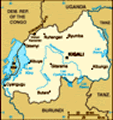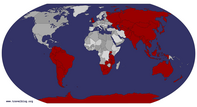Advertisement
Published: January 24th 2009
Faced with the prospect of several days on a bus, and several different buses at that, we'd taken the ‘flashpacker’ option and flown from Arusha in Tanzania to Kigali in neighbouring Rwanda. We’d barely left the airport before we started spotting differences - roads were quieter, streets were clean and roundabouts (they actually had roundabouts!!!) were covered with grass and flowerbeds. That and the way that minibuses at least from Kigali, ran to a schedule, departed on time (whether full or not!), required you to buy a ticket (which often had the price on it!) before getting on and it was almost like we weren't in Africa anymore. Ahhh and then there was the coffee. Kigali seems to have a relatively large population and coffee is a key cash crop here - the result, a couple of excellent coffee houses, great cappuccino’s, not a jar of instant in sight. I was in heaven!
And then there were the carrier bags, or rather lack of them. Plastic bags are banned in Rwanda - shopping gets packed into brown paper bags and roadsides are pleasantly free of the discarded blue plastic bags that had been so prevalent elsewhere on our Africa trip.
Travelling by public transport we'd often watched fellow passengers throw food wrappers, bottles, plastic bags, banana peel and any other rubbish out of the window. Although what really, really annoyed me were the foreigners, who wouldn't dream of littering their home country in such a manner copying the habits of the locals, grrrrr. Consequently pretty much every journey we’d taken had at some point been accompanied by the sight and smell of rotting roadside rubbish, usually right after a refreshment stop. However in Rwanda on one Saturday morning each month everyone has to go and clean the streets - shops, cafes and restaurants all shut, there's no traffic on the roads and few if any people on the streets - it's actually quite spooky. Whether it’s because the regular clean up hinders the build up of roadside rubbish or people litter less because they know they'll have to clean it up later, not seeing a landscape blighted by carrier bags was fantastic.
In Rwanda motorbike taxi’s are the cheap mode of local transport. I really hate motorbikes so if there’s another option I’ll take it. Unfortunately that wasn’t always possible here and a few times we had to use
them. The taxi rank is easy to spot - a line of motorbikes by the roadside, the drivers, depending on the type/size of bike, all sporting either a blue vest and matching blue helmet or a green set. Unlike other countries we’d visited the driver, and in our case the passengers, actually wear a crash helmet! Unfortunately the seemed more decorative than functional, the helmet slipping further and further forward to cover my eyes as we sped along the road. But then perhaps that was a good thing because then I had less opportunity to watch the driver whizzing along, one hand steering the bike and the other holding his mobile phone to his ear. I got off and nearly threw up.
After a few days visiting genocide memorials in and around Kigali we headed off to see the lighter side of Rwanda, starting with some relaxation on the shores of Lake Kivu. One of the great lakes of Africa this stunning area lies between Rwanda and the Democratic Republic of the Congo. The journey from Kigali took us along steep winding (virtually pot-hole free!) roads, unusually with only one passenger vomiting, quietly into his briefcase. The passing countryside
was lush green, hilly and intensively farmed - Rwanda is small geographically but the most densely populated in Africa so it was unsurprising that despite the steepness of the land almost every piece was planted with crops. Women walked alongside the road, tall and elegant with packed baskets of vegetable balanced seemingly effortlessly on their heads, men strained to push bikes loaded with grass and the kids, pristine in their school uniforms kids smiled and waved. Unlike other countries we’d been to every school seemed to have the same colour school uniform.... blue.
We passed a lazy day by the lake with it’s still waters and stunning views, really only moving to walk around the village, an event that seemed to be the social entertainment of the week with everyone stoppingto wave or say hello, one young school girl shyly following me almost all the way back to the guest house. We also took a trip out on the lake with a boatman who it turned out was from the DRC - as we headed back towards land he pointed out a darker area on the landscape in the distance, a UN refugee camp he said where his family
lived with over 18000 other DRC refuges.
Finally we headed to the northwest of the country and the Volcanoes National Park where we’d arranged to go gorilla trekking!! Along with the Virunga National Park in the DRC and the Mgahinga Gorilla National Park in Uganda, both of which it borders, the park is home to about half the worlds remaining @700 mountain gorillas. The rest of this endangered species are found in the Bwindi National Park, Uganda. The day of the trek was an early start and by 7am we were waiting outside the Park HQ, excited, glad that the sky was clear and praying that the heavy rains of yesterday wouldn’t return. Us trekkers were divided into groups, Helen and I being teamed with an American women and a South African couple who left us aghast when whilst driving to the trailhead the bloke rather bizarrely asked our Rwandan guide where he might buy a machete as a souvenir - it seemed in rather bad taste.
Reaching the end of the road, literally, we all piled out of the 4wd and the 5 of us plus 2 park rangers, an armed guard and a guy with a
machete whose job it was to cut a way through the bamboo forest, all headed off across the surrounding farmland. With volcanoes looming high above on both sides and cows loose amongst the crops we were all feeling pleased at how easy the walk was, although the stout walking sticks we'd all been given suggested it wouldn't last. Sure enough when we reached the park boundary and clambered over the rock fence our nice path became thick, gloopy, squelchy mud. Within seconds I'd sunk into it, briefly losing sight of my shoe and from there it was all uphill, a narrow 'path' of mud leading us through the dark forest and higher up the volcano slopes. Compared to other groups though we got off lightly so I can't complain - whereas some walked for 4 hours before they reached the gorillas, we'd only been in the forest for an hour before our guide called a halt. We'd finally met the trackers whose job it is to stay with the animals all day, guarding against poachers - these guys, often former poachers themselves, head up the mountainside at dawn, not returning until dusk.
With the gorillas now only a few
minutes’ walk away we had to leave everything bar our cameras with the trackers. Slightly perturbed that our guide put his water proof trousers on I quickly understood why and was thankful I at least had my waterproof jacket with me. The last part of the walk took us through a mass of stinging nettles, which somehow didn’t sting through waterproofs. Normal trousers were a whole different matter and my recollection of our first 10-15 minutes was not so much of the gorillas but of sliding on steep slopes and falling backwards to sit in a mass of stinging nettles. Ouch.
When I first heard that we were going to see the Sabinyo group I was disappointed. Named for the 3634m volcano on whose slopes they live, the group has just 9 members and is the smallest of the habituated groups that tourists visit. Some other groups have over 20 members with the largest, Susa, having 38 members. As it turned out I think we had one of the best encounters that day - the gorillas were on the ground and out in an open area rather than hidden amongst the trees and darker light of the forest. Lazing
amongst the vegetation right in front of us was Guhonda, the largest silverback in all the groups - he was HUGE and we all took a step back when he got up! Surrounding him were other members of the group, including the ever naughty youngster Big Ben, whilst a short distance away a mum sat with a baby clinging to her chest. You only have an hour with the gorillas and the time just flew. What struck me most were their human like charactersitics - from their changing facial expressions to the dexterity of their hands and way in which they gripped food, their the social behaviour from how the younger ones kept play fighting, rolling around like naughty children with far too much energy, to the fact that they were all so noisy and with their gaze sometimes holding ours, watched us watching them.
Next up more wildlife and waterfalls in Uganda!
Advertisement
Tot: 0.253s; Tpl: 0.014s; cc: 26; qc: 122; dbt: 0.1547s; 1; m:domysql w:travelblog (10.17.0.13); sld: 1;
; mem: 1.5mb


























zsteve
S
Up, close and personal
Hi Wendy Your trip to the mountain gorillas sounds like an awsome experience. Great photos as well Enjoy Uganda